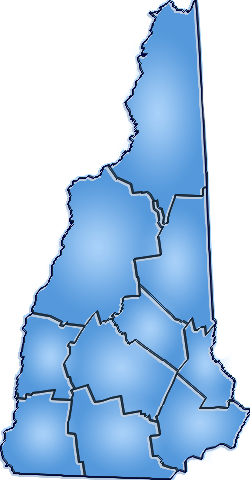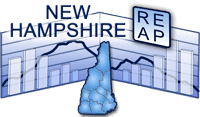Leading, Slipping, Gaining, Lagging Analysis: Assessing Forestry, Fishing, and Related Activities Employment Growth Across New Hampshire Counties  Briefing Report Outline: Page 1 of 8 Forestry, Fishing, and Related Activities Employment Growth County vs Statewide Average: 2010-2022 and 2022  New Hampshire: 2010-2022 = -0.71% 2022 = 0.07% Borrowing from an approach that sometimes appears in the finance sections of the popular press, LSGL analysis is a handy and versatile way to compare, portray and classify the patterns of forestry, fishing, and related activities employment growth across all of New Hampshire's 10 counties. In finance, this technique is used for comparing and assessing the market performance of individual securities or across industry sectors. For example, the performance of the 30 stocks contained within Dow are compared with one another over the past week in contrast to their performance over the past month using the Dow's respective averages as the points of reference. Here in this New Hampshire Regional Economic Analysis Project report, we adopt this approach to gauge and compare the forestry, fishing, and related activities employment growth of New Hampshire's 10 counties over the latest available year (2022) against the backdrop of their growth over the long term period (2010-2022). In so doing we classify their growth and performance into 4 broad categories: Leading, Slipping, Gaining and Lagging. Page 2 of 8 Forestry, Fishing, and Related Activities Employment Growth County vs Statewide Average: 2010-2022 and 2022  New Hampshire: 2010-2022 = -0.71% 2022 = 0.07% This figure displays the 10 counties of New Hampshire as dots on a scattergram, with the vertical axis representing the average annual forestry, fishing, and related activities employment growth rate over the long-term period (2010-2022), and the horizontal axis representing the forestry, fishing, and related activities employment growth rate for the near-term (2022). This figure sets apart those counties whose long-term forestry, fishing, and related activities employment growth exceeded the statewide average of -0.71%, by portraying them in the top two quadrants demarcated at -0.71% on the vertical axis. County whose long-term average annual forestry, fishing, and related activities employment growth rate trailed the statewide average (-0.71%) are distributed in the bottom two quadrants. In all, 1 counties surpassed the statewide average over 2010-2022, while 3 counties fell below. Similarly, the two quadrants on the right of this figure present the positions of the 2 counties whose most recent (2022) forestry, fishing, and related activities employment growth rate exceeded the statewide average (0.07%). The two quadrants on the left feature those 2 counties whose forestry, fishing, and related activities employment growth over 2022 trailed the statewide average. Accordingly, each quadrant portrays the performance of all 10 counties corresponding with their long-term (2010-2022) and near-term (2022) performance relative to their respective statewide averages of -0.71% over 2010-2022 and 0.07% over 2022: Leading counties () (top-right quadrant)...are counties whose average annual forestry, fishing, and related activities employment growth rate surpassed the statewide average both long-term (-0.71%) and near-term (0.07%). Slipping counties () (top-left quadrant)...are counties whose long-term average annual forestry, fishing, and related activities employment growth rate exceeded the statewide average (-0.71%), but whose near-term growth has "slipped" by falling below the New Hampshire average (0.07%). Gaining counties () (bottom-right quadrant)...are counties whose long-term average annual forestry, fishing, and related activities employment growth rate fell below the statewide average (-0.71%), but whose near-term growth has "gained" by registering above the average (0.07%) statewide. Lagging counties () (bottom-left quadrant)...are counties whose average annual forestry, fishing, and related activities employment growth rate fell under the statewide average both long-term (-0.71%) and near-term (0.07%).
Page 3 of 8 Slipping Counties 2022 vs. 2010-2022 Averages  New Hampshire: 2010-2022 = -0.71% 2022 = 0.07% This figure depicts the distribution of the 1 New Hampshire county classified as Slipping (top-left quadrant), in that their long-term average annual forestry, fishing, and related activities employment growth rate outpaced the average statewide (2010-2022 = -0.71%), while they trailed the statewide average near-term (2022 = 0.07%). Again, each county is identified by it's corresponding ranking based on its average annual forestry, fishing, and related activities employment growth rate over 2010-2022. Only 1 (10%) of New Hampshire's 10 counties are classified as Slipping (). Those counties ranked by their long-term average include:
Page 4 of 8 Gaining Counties 2022 vs. 2010-2022 Averages  New Hampshire: 2010-2022 = -0.71% 2022 = 0.07% This figure shows the distribution of the 2 New Hampshire counties classified as Gaining (bottom-right quadrant), in that their long-term average annual forestry, fishing, and related activities employment growth rate posted below the average statewide (2010-2022 = -0.71%), while they outpaced New Hampshire's average near-term (2022 = 0.07%). Again, each county is identified by its corresponding ranking based on its average annual forestry, fishing, and related activities employment growth rate over 2010-2022. Of New Hampshire's 10 counties, 20% (2) are featured as Gaining (). Those counties ranked by their long-term average include:
Page 5 of 8 Lagging Counties 2022 vs. 2010-2022 Averages  New Hampshire: 2010-2022 = -0.71% 2022 = 0.07% This figure depicts the distributions of the 1 New Hampshire county classified as Lagging (bottom-left quadrant). These counties trailed the statewide average annual forestry, fishing, and related activities employment growth both long-term (2010-2022 = -0.71%) as well as near-term (2022 = 0.07%). Again, each county is identified by its corresponding ranking based on it's average annual forestry, fishing, and related activities employment growth rate over 2010-2022. 10% of New Hampshire's counties, 1 of 10, are characterized here as Lagging (). Those counties ranked by their long-term average include:
Page 6 of 8
Page 7 of 8 | ||||||||||||||||||||||||||||||||||||||||||||||||||||||||||||||||||||||||||||||||||||||||||||||||||||||||||||||||||||||||||||||||||||||||||||||||||||||||||||||||||||||||||||||||||||||||||||||||||||||||||||||||


